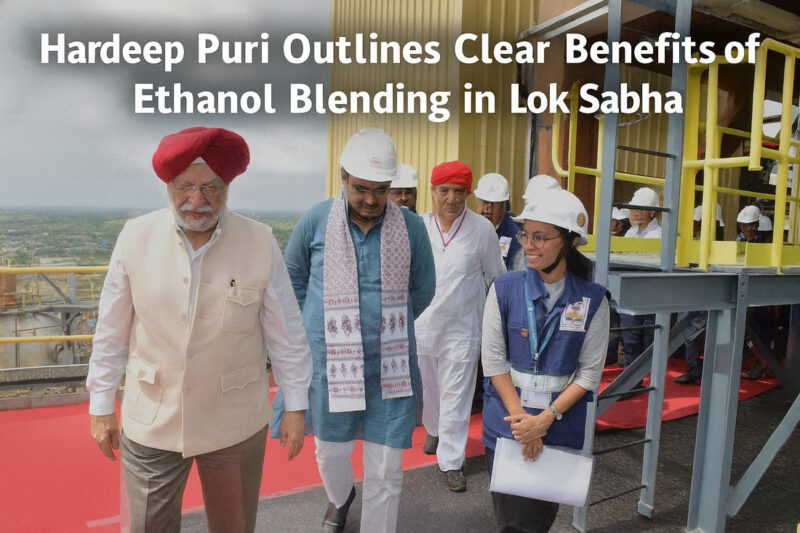 The Hon’ble Petroleum Minister’s written reply to the Lok Sabha puts meaningful numbers on a decade of effort: foreign-exchange savings in the ballpark of ₹1.44 lakh crore, roughly 736 lakh metric tonnes of CO₂ avoided, and about 244 lakh metric tonnes of crude substituted. It is a concise statement of national priorities—cleaner fuel, stronger energy security, and better incomes for farm communities that supply the feedstock. Broadly, the totals are consistent with the rapid growth of the programme: distillery capacity has expanded, annual ethanol lifts have surged, and nationwide blending has moved from low single digits to the high teens, pressing toward E20. In short, the macro picture is one of steady execution and real progress.
The Hon’ble Petroleum Minister’s written reply to the Lok Sabha puts meaningful numbers on a decade of effort: foreign-exchange savings in the ballpark of ₹1.44 lakh crore, roughly 736 lakh metric tonnes of CO₂ avoided, and about 244 lakh metric tonnes of crude substituted. It is a concise statement of national priorities—cleaner fuel, stronger energy security, and better incomes for farm communities that supply the feedstock. Broadly, the totals are consistent with the rapid growth of the programme: distillery capacity has expanded, annual ethanol lifts have surged, and nationwide blending has moved from low single digits to the high teens, pressing toward E20. In short, the macro picture is one of steady execution and real progress.
The very fact that these numbers can be placed before Parliament is itself an achievement. To make this success even more robust—and to win over sceptics who don’t follow the sector closely—a bit more daylight on the arithmetic behind those totals would be a wise next step.
Cumulative figures compress many moving parts: fuel prices that swing month to month, refinery yields that vary by crude and configuration, and emissions factors that depend on where you draw the boundary. The reply is directionally strong; publishing the method notes would make it politically unassailable. Three polite, practical suggestions:
First, foreign-exchange savings. Share a short, year-wise spreadsheet that multiplies ethanol lifted by the petrol it displaced (clarifying whether it’s litre-for-litre or energy-equivalent), alongside the import-parity price series and exchange rates used. When people can trace each line item, debate turns into understanding.
Second, CO₂ avoidance. Clarify whether the estimate is “tank-to-wheel” (tailpipe only) or “well-to-wheel” (including farm inputs, transport, and distillery energy). List the emission factors, energy content per litre, and any credits for co-products. A two-page note is enough.

Karan Bir Singh Sidhu, IAS (Retd.), former Special Chief Secretary, Punjab, writes on the intersection of constitutional probity, due process, and democratic supremacy.
Third, crude substitution. Explain the conversion from litres of ethanol to litres of petrol displaced to crude-tonne equivalents, or adopt a clean energy-equivalent path (megajoules displaced) with transparent refinery yield assumptions. None of this undermines the Minister’s message; it strengthens it. When the spreadsheet is public, critics have less room for conjecture and supporters have clearer talking points.
There is another way to make the case broadly persuasive: speak a little classroom physics. Petrol carries roughly 32 megajoules of energy per litre (about 7,650 kilocalories). Absolute ethanol carries about 21 megajoules per litre (around 5,000 kilocalories). Blend 20 percent ethanol with 80 percent petrol, and E20 lands near 29.8 megajoules per litre (just over 7,100 kilocalories). That is about 7 percent less energy per litre than straight petrol.
Engines cannot create energy; they can only convert what they are given. In a modern, computer-controlled car, the ECU senses the leaner mix and compensates by injecting slightly more fuel per cycle—about seven percent more—to keep power steady. If your car is rated at, say, 88 bhp, it will feel much the same in horsepower and acceleration. The trade-off shows up at the fuel gauge: you burn more litres to do the same work, so your km-per-litre dips by roughly the same seven percent.
In older vehicles that are not recalibrated for E20, the compensation may be imperfect. Drivers may notice a touch less mid-range pull, a hint of knock under load, or rougher idling. Mechanics report more clogged fuel filters—ethanol’s solvency can loosen old tank deposits—early wear in rubber components that weren’t specified for higher ethanol blends, and fuel gauges that drop faster on long runs.
There is a small but real chemistry wrinkle, too. Ethanol is hygroscopic—it absorbs moisture from the air. Even a little water per litre dilutes the blend’s usable energy, can encourage corrosion or clogged filters, and can shave another fraction of a kilometre off each litre’s range, especially in humid conditions or in vehicles with older, poorly sealed systems. None of this contradicts the national benefits cited by the Minister; it simply explains why some motorists experience more frequent fill-ups. Stating the physics plainly—at the pump and in public communication—would make the programme feel more transparent and consumer-aware.
A simple question governs the public’s acceptance: What is my rupee-per-kilometre? If E20 delivers about 93 percent of petrol’s energy per litre and the vehicle keeps the same power, it will burn about seven percent more litres to cover the same distance. Whether the rupee-per-kilometre rises or falls depends on the price relationship between E20 and petrol. The polite, pro-consumer suggestion is straightforward: price by energy content, not just by volume. If E20 has roughly 93 percent of petrol’s energy per litre, aim to keep the per-megajoule price at or below petrol’s. This preserves the consumer’s cost-per-km while still meeting national goals.
Two small labelling reforms would make this logic visible. First, display energy content per litre and the typical km/L delta on the dispenser—clear type, simple phrasing. Second, require two mileage numbers on every new car: one for petrol and one for E20. When motorists can see the physics in plain sight, suspicion evaporates.
The country can maintain its trajectory toward E20 without disadvantaging older vehicles. A dual-grade approach—E20 for the majority, E10 as a protection grade for legacy engines—through this decade provides a smooth transition. It signals inclusivity and respects the sunk costs of households and small businesses that keep vehicles longer.
In parallel, free ECU updates for major BS-IV and BS-VI models would help owners capture the best possible efficiency from E20 while avoiding any avoidable drivability complaints. Making E20-compliance and warranty status searchable by VIN gives clarity at the workshop and peace of mind to buyers and sellers in the used-car market.
Trust is built—or lost—at the nozzle. Because ethanol can carry moisture and loosen residues, rigorous moisture limits, periodic tank cleaning, and upgraded hoses and seals at retail outlets are not cosmetic; they are essential. Surprise audits and public dashboards that list outlets passing or failing basic blend and water checks would go a long way to reassure drivers that their experience at the pump matches the policy promise on paper. When enforcement is visible, the narrative shifts from complaints to confidence.
The Minister’s linkage of blending to farmer incomes is well-taken. To keep that promise resilient, a gradual tilt toward second-generation ethanol (crop residues and other lignocellulosic feedstocks) reduces the risk of food-fuel tensions in weak monsoon years. On the conversion side, making the refinery-yield assumptions explicit—or using a transparent energy-equivalent method—keeps the crude-substitution claim grounded in real refinery physics. These are technical footnotes, but they carry political weight: clarity here disarms both casual scepticism and motivated trolling.
India’s ethanol journey is not a niche story anymore; it touches every driver. A short, repeatable communication template would make the government’s stance even more credible:
A one-pager that summarises the method for forex, CO₂, and crude substitution.
A consumer explainer that states—in everyday language—the energy content of E20 and its typical effect on mileage, and why modern ECUs protect horsepower.
A pricing principle that ties rupees to energy, so motorists know they are not cross-subsidising the transition.
This is not about conceding ground; it is about consolidating gains. The more the public can see the calculations and the physics, the easier it becomes to sustain bipartisan support.
While India is grappling with penal tariffs from the United States on account of its import of discounted Russian oil, the government finds itself carefully walking a tightrope between securing affordable energy, conserving foreign exchange, and responding to pro-consumer concerns at home. In such a fraught international context, the Lok Sabha reply by the Petroleum Minister acquires additional weight: it signals that India is not only managing its external energy vulnerabilities but also moving toward self-reliance through domestic blending. Pro-consumer voices, rightly vigilant about mileage and pump-level transparency, may for now take reassurance from the Cabinet Minister’s clear articulation of cumulative gains—subject, of course, to the publication of the underlying arithmetic that would turn headline claims into a fully verifiable account.
The Union Minister’s reply captures the essential truth: India’s ethanol blending programme is delivering strategic benefits—on foreign exchange, emissions, and energy security—while anchoring new income streams in the rural economy. Those achievements deserve acknowledgment. The next step is to make the story bullet-proof and broadly palatable by publishing the working behind the totals, speaking physics at the pump, pricing by energy rather than by volume, protecting legacy vehicles with a dual-grade strategy, and tightening visible quality control at retail. None of these are heavy lifts; they are courteous, practical enhancements that convert impressive national aggregates into everyday trust. Do that, and the programme will not only keep saving crores and cutting carbon—it will also give concrete shape to Prime Minister Narendra Modi’s clarion call for green energy and a cleaner planet, while securing durable confidence from motorists who meet the policy, litre by litre, on the forecourts of India.